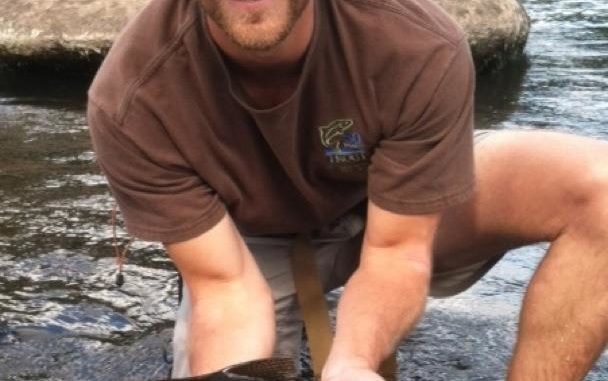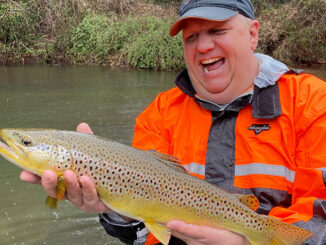
Mitchell County stream is producing plenty of fat fish
Anglers looking for a respite from the heat while still catching fish are finding all they can ask for on Cane Creek. Plenty of chunky rainbow trout are hitting live bait on the small, blue-ribbon stream that flows for 10 miles through Mitchell County.
Perry Filson of Bakersville said this is the best time of year to catch the fattest trout in Cane Creek, especially in the lower part that runs between the NC 226 and NC 80 bridges. This is a delayed-harvest section, meaning for most of the year, this section is only open to catch-and-release angling with strict lure guidelines.
“But it’s open season now. You can use any bait or lure you want, and keep up to seven fish per day,” said Filson, who said cooling off goes hand in hand with fishing tactics. “The right way to do this is by wading directly down the center of the stream.”
Filson started fishing this way primarily because of the abundance of overgrown weeds that line the banks of the creek, but it didn’t take him long to see another big advantage to wading.
“When fishing from the bank, you can’t see under the weeds that extend over the water, and you certainly can’t see the cuts that run under the banks. You also can’t cast to those areas without getting hung up, and that is where the majority of the fish are — especially the big ones. If you’re not wading, you’ll never have a chance to catch these fish,” he said.
Stealth does play a role.
“You can’t just go stomping up and down the creek and expect to catch trout. These fish are wary, and they’ll scatter if you make too much of a commotion,” he said. “The trick is to have some high-quality polarized shades, move very slowly, and look really carefully under the banks. Once your eyes adjust, the fish will seem to materialize. Where you saw nothing but rocks, you’ll suddenly see a handful of fish, all in a straight line and facing upstream.”
It’s up to the angler to present the bait. That can be tricky with briars dangling down from the bank, and tree roots poking out of it. The current can help if you find a safe place to cast just upstream of the fish.
“I fish with a No. 4 hook, and I’ll put a whole nightcrawler on it. Don’t use any weight, and the current can carry it past obstacles if you need it to,” said Filson, who stresses anglers should only cast to the first fish in the line, from upstream.
“If you cast downstream of them and then reel it up from behind them, they’ll scatter. They are facing upstream because they know the current will wash food their way. The current is too fast for anything as small as a worm to naturally move upstream from behind them, so they know something is wrong when that happens” Filson said.
Once his bait reaches that first fish, Filson keeps his line taut, letting the worm dangle in the trout’s face.
“It gets interesting here. Sometimes, that fish will devour the worm, and then it’s game on. Other times, you really start to appreciate how smart these fish are. Sometimes they’ll get nervous and pull out of line, drift backwards behind the other fish, then get back in line at the back of the pack. Now, you’re dangling the bait at the second fish.” Filson said.
This also happens if the first trout tries, but fails, to get the bait.
“It’s just an amazing thing to see,” he said.
Fishing this way, said Filson, does take plenty of patience.
“You’re not going to catch your limit in record time, and you’re probably only going to catch one fish from each little group you find. You just have to wade up and down, carefully peering under the banks until you see another school, but it’s worth the time, especially for the size of these fish. These are big fish. I’m talking about 20 to 24-inch trout here. You’re not going to catch those from the banks on this creek,” he said.
Filson uses 15-pound braid with a 12-inch leader of 8-pound fluorocarbon, and he prefers small, mostly 500 series spinning reels. Because this creek is so narrow, he sticks to 5-foot rods. The most important piece of equipment though, is sunglasses.
“If you don’t have high-quality, polarized shades, you’re not going to see these fish,” he said.





Be the first to comment